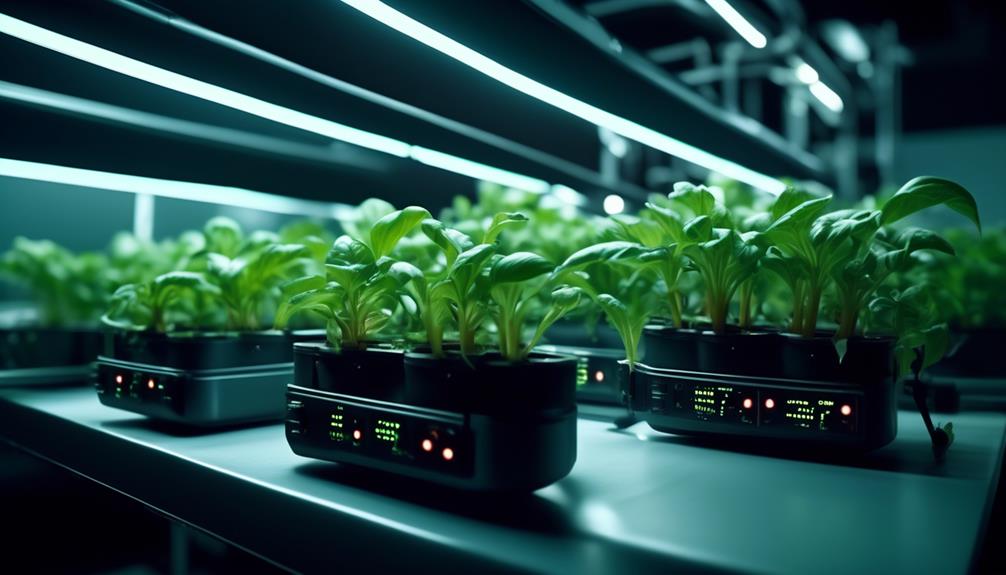Table of Contents
Hydroponic gardening offers a unique and efficient way to grow crops, especially for those new to the practice. The choice of crops can significantly impact the success of a beginner’s hydroponic setup. With a variety of options available, selecting the right crops can be a daunting task.
However, understanding the best hydroponic crops for beginners is essential to kickstart a successful journey into this innovative growing method. From leafy greens to flavorful herbs and even fruit-bearing plants, the options are diverse and captivating.
Key Takeaways
- Leafy greens and herbs such as lettuce, spinach, and basil are excellent choices for beginners in hydroponic gardening.
- Tomatoes and cucumbers are resilient crops that can be successfully grown hydroponically, providing a rewarding experience for beginners.
- Growing strawberries hydroponically requires precise control of growing conditions and proper harvesting techniques for continued success.
- Peppers and green onions are well-suited for hydroponic cultivation, offering fresh and flavorful yields with minimal intervention.
Leafy Greens
Leafy greens, due to their rapid growth and adaptability to various hydroponic systems, are an excellent choice for beginners venturing into hydroponic crop cultivation. Hydroponic lettuce, spinach, and lettuce grows exceptionally well in these systems, making them ideal for those new to hydroponics.
Lettuce, in particular, is a popular choice due to its relatively low maintenance requirements and quick growth cycle. Similarly, spinach is a versatile and nutritious leafy green that thrives in hydroponic setups. Moreover, rainbow chard, with its vibrant and colorful stems, adds an aesthetic appeal to hydroponic gardens.
These leafy greens can be cultivated in a range of hydroponic systems, including NFT (nutrient film technique) and ebb and flow systems, offering beginners the flexibility to choose a setup that best suits their preferences and available space. Furthermore, the fast growth of leafy greens provides beginners with a satisfying and rewarding experience, as they can harvest their crops in just a couple of weeks.
Not only are leafy greens valuable for their culinary uses and nutritional benefits, but cultivating them in hydroponic systems also serves as an excellent learning opportunity for beginners to understand nutrient regimens and plant care in a controlled environment.
Herbs
Herbs are a versatile and popular choice for hydroponic cultivation, offering a wide range of culinary and aromatic benefits to growers.
When it comes to hydroponic systems, herbs are a natural fit due to their fast growth and the ability to thrive in nutrient-rich water. This makes them suitable for smaller setups, such as counter-top hydroponic systems, providing easy access to fresh herbs and allowing for year-round availability.
Commonly grown herbs in hydroponics include coriander, mint, parsley, basil, sage, thyme, chives, oregano, peppermint, and rosemary. To maximize the harvest, it is recommended to harvest small amounts of herbs at a time, extending the harvest and ensuring a continuous supply.
Tomatoes

While the cultivation of herbs in hydroponic systems offers numerous culinary and aromatic benefits, transitioning to the topic of tomatoes opens up a new realm of learning about flowering and fruiting in hydroponics. Hydroponic tomatoes present an exciting opportunity for beginners to delve into the world of hydroponic gardening. Here are essential points to consider:
- Resilient Yield: Hydroponically grown tomatoes are known for their ability to produce fruits even if minor issues occur during the growing process, making them a forgiving crop for beginners to cultivate.
- Structural Support: Providing adequate support for tomato plants is crucial to prevent tipping or branch breakage as the plants mature. This can be achieved through staking or trellising methods, ensuring the plants grow upright and healthy.
- Optimal System: Utilizing a deep water culture bucket system is recommended for growing tomatoes hydroponically. This system provides the necessary oxygen and nutrient delivery for robust tomato growth and a bountiful harvest.
With the right knowledge and care, hydroponic tomatoes can thrive, offering a rewarding experience for beginners venturing into hydroponic gardening.
Cucumbers
Cucumbers are a popular choice for hydroponic cultivation due to their rapid growth and high yield potential. When growing cucumbers, selecting a suitable variety and providing proper support are essential factors for success.
Additionally, choosing varieties resistant to powdery mildew can contribute to a more successful harvest in hydroponic systems.
Cucumber Varieties
When selecting cucumber varieties for hydroponic cultivation, it is essential to consider their suitability for the chosen system and their resistance to common diseases such as powdery mildew.
Key Considerations for Choosing Cucumber Varieties:
- Vining vs. Bush Varieties: Consider the available space and support structures when choosing between vining and bush cucumber varieties for hydroponic cultivation.
- Disease Resistance: Opt for cucumber varieties with high resistance to powdery mildew to ensure successful growth in hydroponic systems.
- Support Requirement: Vining cucumber plants require support from a cage or trellis in a hydroponic setup, so ensure the chosen variety aligns with the support system in place.
Cucumbers are excellent hydroponic vegetables, yielding abundantly and making them a rewarding choice for those looking to grow cucumbers hydroponically.
Growing Techniques
Optimize the growth of hydroponic cucumbers by implementing precise nutrient delivery and environmental controls to ensure optimal conditions for their development.
For hydroponic beginners, a DIY hydroponic system offers an innovative approach to cultivating cucumbers. Consider the Nutrient Film Technique (NFT) for growing hydroponic cucumbers, as it allows for efficient nutrient delivery and oxygenation to the roots.
Maintain the pH levels of the nutrient solution between 5.8 and 6.0 to ensure that the plants grow vigorously.
Additionally, control the temperature and humidity within the growing environment, aiming for temperatures around 75-85°F and humidity levels between 60-70%. These measures will promote healthy growth and high yields.
Implementing these techniques will enable beginners to successfully grow cucumbers hydroponically, leading to a rewarding and productive cultivation experience.
Strawberries

Strawberries can be a rewarding crop for beginners in hydroponic gardening. Understanding the specific growing conditions and harvesting techniques is essential for a successful harvest.
It is important to pay attention to the pH levels and choose suitable varieties for optimal growth and yield.
Growing Conditions
Strawberry cultivation in hydroponic systems requires precise control of growing conditions to maximize yield and minimize potential challenges. When growing strawberries hydroponically, it is important to ensure that the plants receive plenty of light, as they need at least 10-12 hours of direct sunlight or artificial light daily.
Additionally, maintaining proper nutrient levels in the hydroponic setups is crucial for the successful growth of strawberries. Beginners should focus on learning about the specific nutrient needs and requirements of strawberries before expanding their hydroponic garden.
It’s also essential to ensure that the growing environment has adequate ventilation and airflow to prevent issues such as mold and mildew. By providing the right conditions, strawberries can grow well and prove to be an excellent hydroponic crop for beginners.
Harvesting Techniques
When preparing to harvest strawberries grown in a hydroponic system, it is essential to employ precise techniques to ensure the continued success of the plants, building on the meticulous growing conditions previously established.
Hydroponically well-grown strawberries are a popular choice due to their ease of growth and continual production.
To harvest, carefully use scissors to cut the strawberries at the stem, leaving a small portion of the stem attached. It’s crucial to pick the strawberries when they are fully red and ripe, as they will not ripen further after being picked.
During the peak season, strawberries should be harvested every 2-3 days to ensure continual production. Gently handle the strawberries to avoid damaging the delicate fruit, and make sure they are completely dry before harvesting to prevent moisture-related issues.
Peppers
Peppers are a versatile and popular crop choice for beginners in hydroponic farming due to their suitability for indoor cultivation and minimal intervention requirements.
When it comes to growing peppers hydroponically, there are several key aspects to consider:
- Choosing the Right Variety: Selecting the appropriate type of peppers is crucial for successful hydroponic cultivation. Varieties such as bell peppers, chili peppers, and sweet peppers are well-suited for hydroponic systems due to their compact growth habits and high yield potential.
- Optimal Growing Conditions: Providing the right growing conditions is essential for the successful cultivation of peppers. This includes maintaining the ideal temperature, humidity, and light levels to promote healthy growth and robust fruit production.
- Pollination Techniques: While self-pollinating peppers require minimal intervention for successful growth, providing extra attention, such as gentle shaking or the use of a small brush, can increase pepper yield by aiding in the pollination process.
Can the Hydroponic Crops for Beginners be Adapted for Cannabis Cultivation?
Many beginners wonder if hydroponic systems for cannabis can be adapted for their crops. The good news is that hydroponic systems for cannabis can indeed be used for other plants like vegetables and herbs. With a little research and experimentation, beginners can adapt these systems for their own cultivation needs.
Green Onions

A popular choice for hydroponic cultivation, growing green onions indoors offers a convenient and efficient way to produce fresh and flavorful onions. They are well-suited for hydroponic systems, as they grow faster and can be easily maintained in a hydroponic garden. Although green onions grown hydroponically may be smaller than those grown outside, they can still be well-grown and packed with flavor. To ensure optimal growth, adjusting seed density and using wider pods in the hydroponic system can improve green onion development. Rise Gardens seedless pods are suitable for growing green onions and are a great option for beginners looking to start their hydroponic journey with this crop. The following table provides an overview of key considerations when growing green onions hydroponically:
| Consideration | Description |
|---|---|
| Suitable Pod | Rise Gardens seedless pods |
| Growth Size | Smaller than outdoor growth, but well-grown |
| Seed Density | Adjust for optimal growth |
| Hydroponic System | Efficient for indoor cultivation |
| Flavor | Fresh and flavorful |
Growing green onions hydroponically is a practical and rewarding venture for beginners, providing a fresh supply of this versatile ingredient.
Frequently Asked Questions
What Is the Easiest Thing to Grow Hydroponically?
The easiest thing to grow hydroponically depends on the grower’s goals. Nutrient solutions, growing media, pH levels, lighting options, and watering techniques are key factors to consider for successful hydroponic cultivation.
What Is a Good Starter Plant for Hydroponics?
A good starter plant for hydroponics is leafy greens, such as lettuce or spinach. They are well-suited for hydroponic systems due to their minimal nutrient solution and lighting requirements, adaptability to various growing mediums, pH levels, and water temperature.
What Is the Most Profitable Hydroponic Crop to Grow?
The most profitable hydroponic crop is often determined by market demand, production costs, and yield capacity. High-value crops like microgreens, strawberries, and tomatoes are commercially viable, offering top earnings and making them best-selling hydroponic produce.
What Are the 5 Best Type of Plants Grown in Hydroponic Systems?
When considering the best plants for hydroponic systems, factors such as nutrient requirements, growth rates, disease resistance, harvest yields, and environmental impact are vital. Leafy greens, tomatoes, cucumbers, strawberries, and herbs are optimal choices.
Conclusion
In conclusion, hydroponic gardening offers a great opportunity for beginners to grow a variety of crops such as leafy greens, herbs, tomatoes, cucumbers, strawberries, peppers, and green onions.
One interesting statistic to note is that hydroponic crops can grow up to 50% faster than traditional soil-grown plants, providing a quicker and more efficient way to harvest fresh produce.
With the right knowledge and resources, anyone can successfully cultivate these crops in a hydroponic system.











